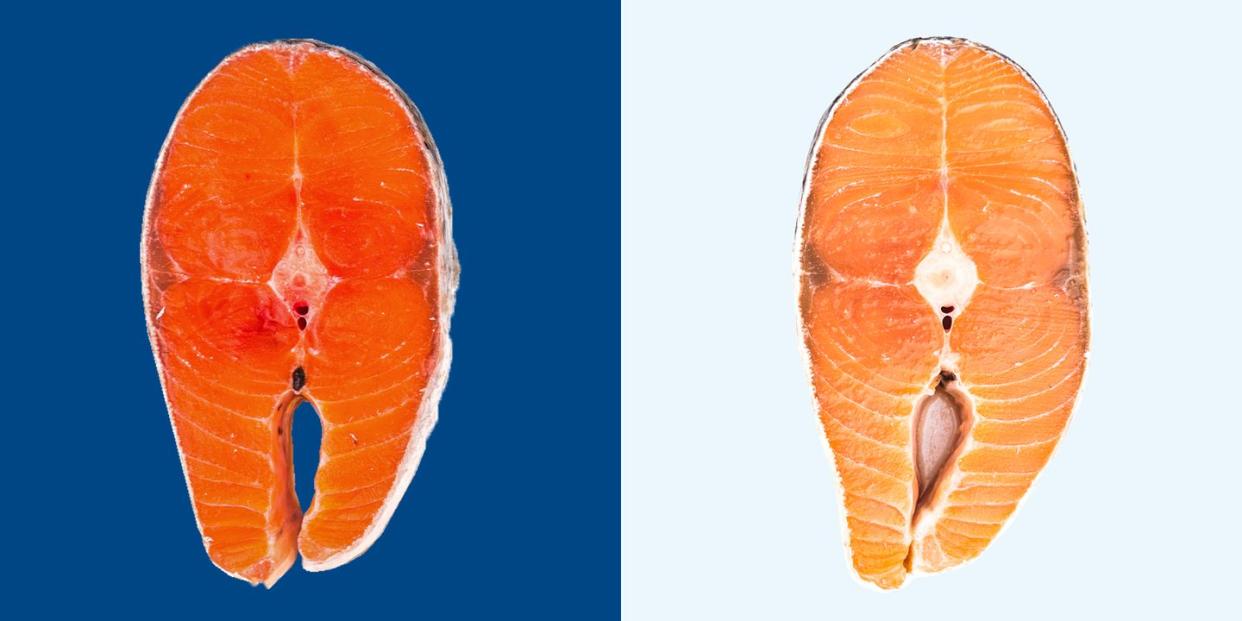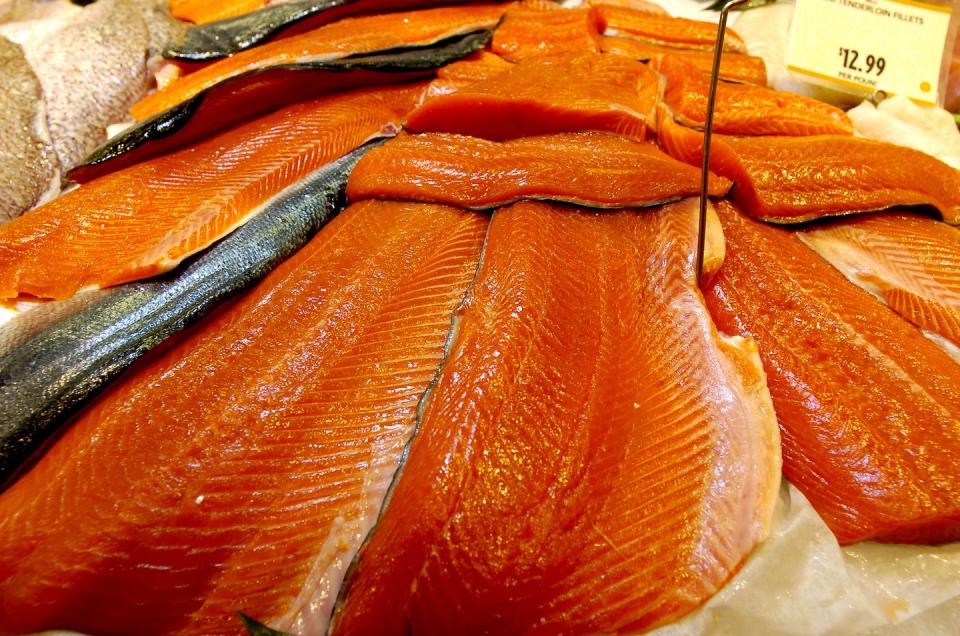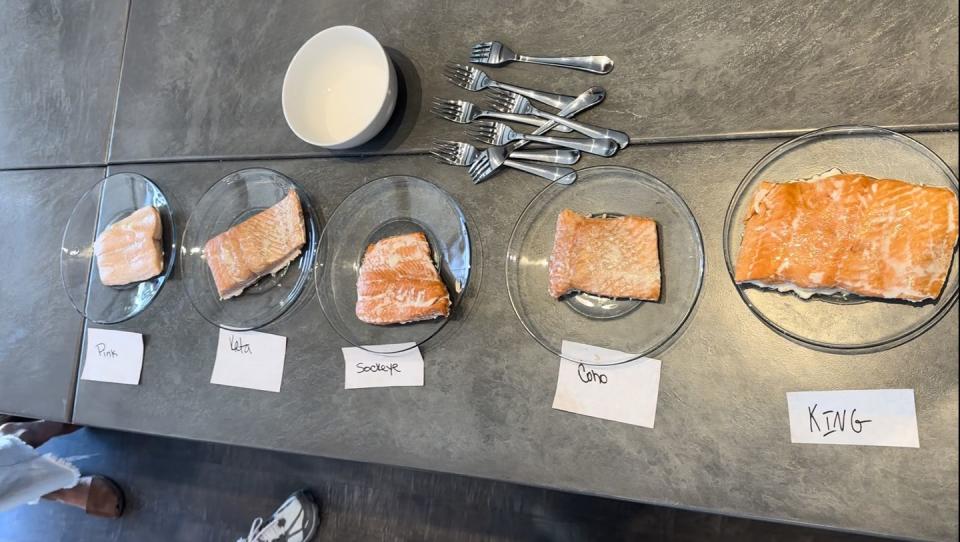Your Farmed Salmon Isn’t Actually Pink—They’re Dying It That Color

Doctors, nutritionists, and food gurus on TikTok swear by adding salmon to your diet. Experts say it’s a good source of lean protein, omega-3 fatty acids, and nutrients like iron and vitamin D. But before you toss a tray of cellophane-wrapped fish into your grocery cart, you might be wondering where your salmon actually comes from. Sure, it comes from the store, but what does a label like “Norwegian Farm-Raised Fresh Atlantic Salmon” really mean? Then you might think, “What even is farm-raised salmon?” And whether you should buy it instead of wild-caught salmon. Why are they different prices? And what’s the deal with some salmon allegedly being dyed pink?
Farmed Salmon vs. Wild Salmon
Let’s rip the band-aid off early. Any Atlantic salmon you buy is farm raised, whether or not it’s Norwegian. Wild Atlantic salmon do exist, and they used to be abundant in the Northeastern coastal rivers of the U.S. But due to habitat destruction and overfishing, they are now considered an endangered species. So the global commercial fishing industry turned to farming fish like salmon on an industrial scale to meet the worldwide demand. But as with any disruption to natural occurrences, there are a few problems with that pivot.
The fish-farming game isn’t much different than any other type of livestock farming. It involves crowded man-made environments that can leave farmed fish more susceptible to infections and disease. To counter this problem, antibiotics can be added to the fish feed, and those antibiotics ultimately end up on the plate and in the stomach of the person consuming the fish.

Is Farmed Salmon Actually Gray?
The answer you’ve been waiting for: yes, it is. That vibrant pink hue that you look for in Atlantic salmon is just a byproduct of supplements that are added to the fish feed to mimic the natural food that wild salmon eat. So, yes, that Atlantic salmon you toss into your grocery cart was originally a milky gray color.
Varieties like coho, sockeye, or king salmon are wild-caught and are naturally a darker, pinkish-orange color.
How Is Wild-Caught Salmon Different?
The regulated wild-caught fishing industry is a completely different ball game. As opposed to raising salmon encased in a large underwater net, commercial fishing vessels gather fish from their natural habitat. The salmon’s population density, life cycles, migration patterns, sustainability reports, and a host of other factors are assessed by teams of marine biologists and technicians as part of the regulation process. According to the Alaska Seafood Marketing Institute, fishermen will adjust their expectations and fish more of whichever species are most abundant, rather than further depleting varieties that might need some time to replenish their population. Maintaining a sustainable population is crucial to the fishing industry, particularly in Alaska, California, and Oregon, where fish farming is outlawed.
Wild-caught and farm-raised salmon also differ in nutritional value. Wild salmon is more nutritionally dense than farm-raised salmon and can contain up to three times less fat, fewer calories, and more vitamins and minerals like iron, potassium, and b-12. Unfortunately, since the availability of wild-caught salmon exceeds demand, the price per pound is almost always more than that of farmed salmon. Depending on the time of year and a host of environmental factors, certain varieties of wild salmon can be so abundant that they rival the price of farmed salmon.

Okay, But Do They Actually Taste Any Different?
Let’s say you don’t care about gray salmon or antibiotics or any of that. You’re only here for the taste test. In that case, I’m here to tell you there is in fact a difference in taste between wild-caught and farm-raised salmon. Wild salmon eat, well, things that are in the wild. Their diets are varied but include natural prey like zooplankton, shrimp, herring, and krill. Since farm-raised salmon eat processed feed, their diet affects their nutritional value and overall flavor. It’s like how you can taste the difference in organic grass-fed beef and free-range chicken—animals that have had the chance to live wild just flat-out taste better. You could also say that they just taste like they naturally should taste.
So What’s The Verdict?
The answer is complicated, and to be honest, I don’t have a definitive one. Wild salmon is unarguably better in terms of quality and nutrition. But it isn’t nearly as widely available as farmed salmon and can be cost-prohibitive to the average consumer. And with the skyrocketing price of groceries, having to choose between a sustainable cost of living and sustainable food choices can become all too frequent.
One possible solution? Awareness and balance. Remaining aware of what you spend time, money, and calories on is invaluable. Balance your nutritional and environmental needs with your wallet’s needs. Buy wild fish when you can (even if it’s just to do your own taste test!) and get farmed when your budget needs a breather.
You Might Also Like

